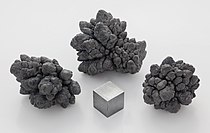
Back Koolstofgroep Afrikaans Grupo d'o carbonio AN مجموعة الكربون Arabic Elementos del grupu 14 AST Dövri sistemin 14-cü qrupu Azerbaijani Seka karbon BAN Група 14 на периодичната система Bulgarian কার্বন শ্রেণি Bengali/Bangla 14. grupa hemijskih elemenata BS Grup del carboni Catalan
| Carbon group (group 14) | |||||||||||
|---|---|---|---|---|---|---|---|---|---|---|---|
| |||||||||||
| ↓ Period | |||||||||||
| 2 | Carbon (C) 6 Other nonmetal | ||||||||||
| 3 | Silicon (Si) 14 Metalloid | ||||||||||
| 4 | Germanium (Ge) 32 Metalloid | ||||||||||
| 5 | Tin (Sn) 50 Other metal | ||||||||||
| 6 | Lead (Pb) 82 Other metal | ||||||||||
| 7 | Flerovium (Fl) 114 Other metal | ||||||||||
|
Legend
| |||||||||||
The carbon group is a periodic table group consisting of carbon (C), silicon (Si), germanium (Ge), tin (Sn), lead (Pb), and flerovium (Fl). It lies within the p-block.
In modern IUPAC notation, it is called group 14. In the field of semiconductor physics, it is still universally called group IV. The group is also known as the tetrels (from the Greek word tetra, which means four), stemming from the Roman numeral IV in the group names, or (not coincidentally) from the fact that these elements have four valence electrons (see below). They are also known as the crystallogens[1] or adamantogens.[2]
- ^ Liu, Ning; Lu, Na; Su, Yan; Wang, Pu; Quan, Xie (2019). "Fabrication of g-C3N4/Ti3C2 composite and its visible-light photocatalytic capability for ciprofloxacin degradation". Separation and Purification Technology. 211: 782–789. doi:10.1016/j.seppur.2018.10.027. Retrieved 17 August 2019.
- ^ W. B. Jensen, The Periodic Law and Table Archived 2020-11-10 at the Wayback Machine.
© MMXXIII Rich X Search. We shall prevail. All rights reserved. Rich X Search



